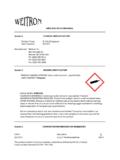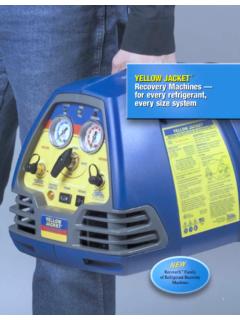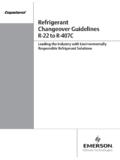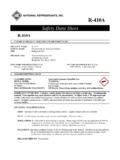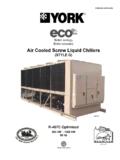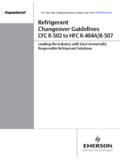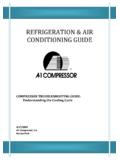Transcription of Product Name: R-410a Refrigerant - Weitron
1 SDS Information Section 1. CHEMICAL Product SECTION Product name : Date Prepared: R- 410a Refrigerant 05-2015 Manufacturer : Weitron , In c. 801 Pencader Dr. Newark, DE 19702 PH: (800)-398-3816 Fax: (302)-455-6656 Section 2. HAZARDS IDENTIFICATION Product HAZARD CATEGORY: Gases under pressure. Liquefied Gas. LABEL CONTENT: Pictogram SIGNAL WORD: WARNING HAZARDOUS WARNI NGS: Contains gas under pressure; may explode if heated. HAZARDOUS PREVENTION MEASURES: Protect from sunlight. Store in a well-ventilated plac e. OTHER HAZARDS: Misuse or intentional inhalation abuse may lead to death without warning. Vapor is heavier than air and can cause suffocation by reducing oxyg en available for br eathi ng.
2 Rapid evaporation of the liquid may cause frostbite. Section 3. COMPOSITION/INFORMATION ON INGREDIENTS CHEMICAL FAMILY Weight % CAS # Description 354-33-6 Pentafluoroethane (HFC-125) 50% 75-10-5 Difluoromethane (HFC-32) 50% Thi s pr oduct contains no known hazardous materi als as defined by the OSHA Hazard Communication Standard 29 CFR Health 1 Flammability 0 Reactivity 1 Emergency Overview: Contents under pr essure. Frostbi te-li ke effects may occur if the liquid or escaping vapors contact the eyes or skin. In halation overexposure may cause: Central nervous system depression with dizziness, confusion, loss of coordination, drowsiness, unconsciousness or death. Suffocation if air is displaced by vapors.
3 Pot ential Health E ffects: Eyes: Frostbi te-li ke effects may occur if the liquid or escaping vapors contact the eyes. Skin: Frostbi te-li ke effects may occur if the liquid or escaping vapors contact the skin. In halation: Inhalation overexposure may cause: Central nervous system depression with dizziness, confusion, loss of coordination, drowsiness, unconsciousness or death. Suffocation, if air is di splaced by vapors. Ingestion: Not considered a potential route of exposure Carcinogeni ci ty: No known c ancer hazards. HMIS Classification: Section 4. FIRST AID MEASURES Eye Contact: In case of contact, immedi ately flush eyes with plenty of water for at least 15 minutes. Get medical attention immediately.
4 Skin Contact: Wash affected area i mmediately with large amounts of soap or water fo r 15 minutes. Remove contaminated clothing and shoes, and wash before reusing. Treat affected area for frostbite if necessary by gently warming. May irritate skin. If irritation continues contact Phys ician. In halation: If in haled, immediately remove to area with fresh air. If not breathi ng give artificial respi ration. If br eathing is diffic ult give oxygen. Contact Ingestion: Is not considered a potential route of exposure. Advice to Physician Because of the possible distur bances of cardiac rhythm, catecholamine drugs, such a s epinephrine, should be used with caution and onl y in situations of emergency lif e support.
5 FI RE F IGHTING MEASURES Section 5. Flash Poin t: Does not flash Flammable limits in Air LEL: None UEL: None Based on ASHRAE Standard 34 with match ignition Extin guishing Medi a: Water, carbon dioxide, foam or dry powder. Fire & Explosion Hazards: Not flammable at ambi ent temperatur es and atmospheric pr essur e. Material will become combustible when mixed with air under pressure and exposed to ignition sources. Hazardous th ermal decomposition products ( Carbon oxides, Hydrogen Fluoride, Carbonyl fluoride) Fire Fighting Instructions: Contents under pressure and container may rupt ure when exposed to high temperatur e. Product may act as asphyxiate. As in any fire, wear self-contained breathi ng apparatus pr essure- demand MSHA/NIOSH (approved or equivalent) and full pr otective gear.
6 Contain runoff water. Contaminated extinguishing water must be di sposed of in accordance with a pplicable regulations. Avoid breathing smoke, fumes, and decomposition products. Section 6. ACCIDENTAL R EL EASE MEASURES Safeguards (Personnel) Evacuate personnel to safe areas. Ventilate area. Wear appropriate pers onal pr ot ectiv e equipment Initial Containment Contain spilled material. Do not allow material to enter soil or surface water. Product evaporates Spill Procedures Contain spilled material. Large spillage shoul d be dammed-off and pumped into containers. Section 7. HANDLING AND STORAGE Handling (Personnel) Do not breathe vapors. Do not get in eyes, on skin or clothing. Wash hands thoroughly after handling.
7 Wash contaminated clothing before reuse. Use appro priate personal protectiv e equipment when using material. Do not punctur e or drop cans. Do not expose cans to high heat or open f lame. Handling (Physical Aspects) Avoid contact with strong oxidizing agents. Avoid contact with eyes and skin. Keep away from children. Storage Precautions Pr ot ect containers from phys ical damage. Do not Punctur e, incinerate or store cans above 120 F . Keep in cool dry area out of direct sunlight. Section 8. EXPOSURE CONTROL/PERSONAL PROTECTION Engineering Controls: Good general ventilation shoul d be sufficient under normal use conditions. Eye/ Face Prot ective Requirements: Wear safety glasses , s plash goggles or face shield.
8 Where contact with t his material is likely, eye pr otection is recommended. Skin Protection: Wear protective gloves to minimize skin contamination. When prolonged or frequently repeated contact coul d occur , use protective clothing impervious to t his material. Respiratory Protection: Under normal use conditions, with adequate ventilation, no special handling equipment is required. Miscellaneous Use good personal hygiene practices; limit exposure to pr oduct whenever possible to minimize clean-up. Exposure Limit Guidelines Exposure Limit Values Pentafluoroethane AEL 1,000 ppm 8 & 12 hr. TWA Difluoromethane AEL 1,000 ppm 8 & 12 hr. TWA AEL is the Accept able Exposur e Limit as determined by Dupont Section 9.
9 PHYSICAL A ND CHEMICAL PROPERTIES Form: Liquefied Gas Color: Colorless Odor: Slight ethereal odor Boili ng Point: C ( F) Solubility in Water: not determined Vapor Pressure: psig @ 70 F Vapor Gravity: Not Determined Specifi c Gravity: 1. 06 @ 25oC (77oF) Liqui d Density: g/cm3 @25oC (77oF) PH: <7 Volatile Organic Compounds (VOC) Not Determined Flash point & additi onal flammability data found in section 5. Section 10. STABILITY AND REACTIVITY Stability Thi s compound is st able at ambi ent conditions. Polymerization Hazardous polymerization will not occur. Conditions to avoid Do not mix with air above atmospheric pr essure or oxygen. Do not puncture, incinerate or store cans above 120 F. Keep in cool dry area out of direct sunlight.
10 Incompatibility with other materials Avoid contact with strong oxidizing agents. Incompatible with al kali or alkaline earth metals powdered aluminum, Zink, etc. Decomposition Avoid hi gh temperatures or open flames whi ch can decompose material forming hydr ofluoric ac id, and possibly carbonyl halides. Section 11. TOXICOLOGY INFORMATION Pentafluoroet hane (HFC-125) Dermal : not applicable Oral : not applicable In halation 4 h LC50 : >800000ppm, rat In halation (LOAEC) : 100000ppm dog Cardiac sensitization Skin Irritation : No irritation, not tested on animals Not expected to cause skin irritation based on expert review o f pr operties of the substance Eye I rritation : No irritation, not tested on animals Not expected to cause skin irritation based on expert review o f pr operties of the substance Skin Sensitization : Not tested on animals Not expected to cause sensitization based on expert review of the pr operties of the substance Repeated dose toxicity.

